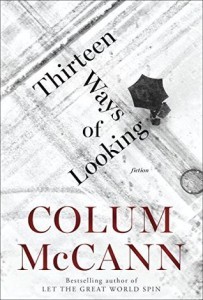2015 Reading: Thirteen Ways of Looking by Colum McCann
 Thirteen Ways of Looking by Colum McCann
Thirteen Ways of Looking by Colum McCann
Without question, Colum McCann is one of my favorite writers. His novel Let the Great World Spin blew me away and made me question whether there was any point in continuing my own writing if I could never approach that level of greatness. I’ve also loved his other books, including Transatlantic, which in its way was equally impressive. (I also had the good fortune of meeting McCann and spending time with him at Washington & Lee University’s Tom Wolfe Seminar a couple of years ago; that experience only made me admire him more.)
So I was excited at the prospect of a new book, and Thirteen Ways of Looking does not disappoint. The book consists of four short stories, although the first one, “Thirteen Ways of Looking,” is novella length. That story has thirteen sections, incorporating each stanza of Wallace Stevens’s poem “Thirteen Ways of Looking at a Blackbird” as an epigraph. It is, essentially, a murder mystery, as detectives examine all the evidence surrounding the death of a retired judge, Peter Mendelssohn. The various points of view, like the surveillance cameras that provide clues, give the reader many ways of looking at the incident, enough perhaps to solve the crime, and yet not enough to see everything. There are, it seems, more than thirteen ways of looking.
The second story, “What Time is it Now, Where You Are?” is wonderful, but a bit more ordinary. It begins in the mind of a writer on deadline who is struggling to write a short story for a New Year’s Eve themed publication. He settles on the story of a marine posted to Afghanistan, but as he writes, and as the character evolves and becomes more complicated, the writer has more and more questions. There are thirteen sections to this story as well, and in the last section the questions pour out. Writers will relate.
The third story is “Sh’khol,” a Hebrew word that means a parent who has lost a child. Rebecca and her son are at a cottage in Galway. Tomas is adopted–Rebecca’s marriage then ended–and he has developmental problems. Where does the thirteen come in? “Thirteen years old and there was already a whole history written in him.” The word “sh’khol” is in her mind when Tomas goes missing.
The final story, “Treaty,” is perhaps the most compelling (although I haven’t yet discovered its “thirteen”). Here a nun who was kidnapped and raped at the hands of a rightwing militiaman spots her torturer on a televised report of a peace conference being held in London. But there’s something wrong — he’s now representing the other side of conflict. Has he changed? She goes to London to find out.
These are remarkable stories of intense conflict that share something universal–a search for grace. How do we live in this world?
In an Author’s Note at the end of the book, McCann makes reference to a severe beating he endured in June of 2014 in the midst of working on these stories. It’s hard not to read the stories in light of that incident and his own reaction to it, which you can and should read about here in his Victim Impact Statement.



